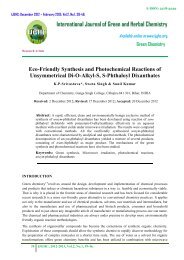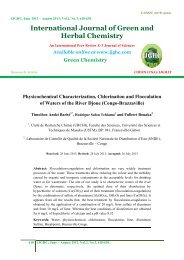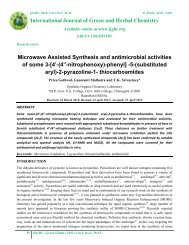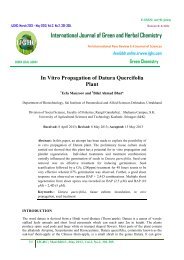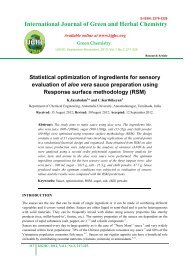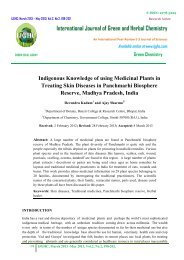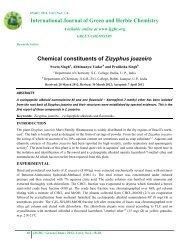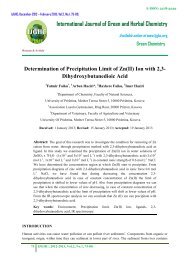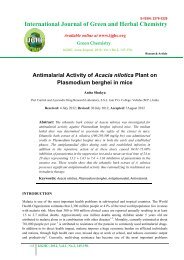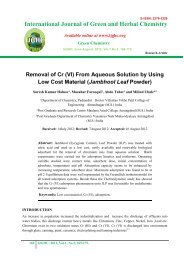Ethno Medicinal Plants Used By Traditional Healers as ... - IJGHC
Ethno Medicinal Plants Used By Traditional Healers as ... - IJGHC
Ethno Medicinal Plants Used By Traditional Healers as ... - IJGHC
- No tags were found...
You also want an ePaper? Increase the reach of your titles
YUMPU automatically turns print PDFs into web optimized ePapers that Google loves.
<strong>IJGHC</strong>, September -2013-November 2013; Vol.2, No.4, 901-907.International Journal of Green andHerbal ChemistryAn International Peer Review E-3 Journal of SciencesAvailable online at www.ijghc.comHerbal ChemistryE-ISSN: 2278-3229Research ArticleCODEN (USA): IJGHAY<strong>Ethno</strong> <strong>Medicinal</strong> <strong>Plants</strong> <strong>Used</strong> <strong>By</strong> <strong>Traditional</strong><strong>Healers</strong> <strong>as</strong> Remedy for To Cure Diabetes inGautala Sanctuary of Kannad Taluka, DistrictAurangabad (Mahar<strong>as</strong>htra)Anil A. Kshirsagar 1 , Vik<strong>as</strong> Gambhire 2, & Ravi Patil 31UG & PG Department of Botany, Shivaji Arts Commerce & ScienceCollege Kannad, District Aurangabad.(MS)2 Department of Botany, Government College Aurangabad (MS)3 Department of Botany,Deogiri college Aurangabad (MS)Received: 15 August 2013; Revised: 30 August 20132013; Accepted: 5 September 2013Abstract: The present paper deals with study of 20 species of ethno medicinal plantswhich are used by traditional healers for curing diabetes or the peoples living in thevicinity of Gautala Sanctuary of kannad taluka, Aurangabad (Mahar<strong>as</strong>htra) In the presentpaper ethno medicinal plants can be used by the traditional practitioners. It is analternative bioresources for the pharmaceutical industries. The tribal community used thetraditional knowledge of plants for different dise<strong>as</strong>es. The present survey made by thehelp of interviews, observation, information and discussion with the practitioners.Though now a days the availability of modern system of medicines such importantknowledge of tribal’s are need to be documented and preservation of these practices arean essential t<strong>as</strong>k. Keeping this view in mind the present paper information is undertaken.The experienced local practitioners have developed their own way of treatment byacquiring the knowledge for their predecessors.Keywords: <strong>Ethno</strong> medicinal plants, Diabetes, Gautala sanctuary, <strong>Traditional</strong>practitioners.901 <strong>IJGHC</strong>, September -2013-November 2013; Vol.2, No.4, 901-907.
<strong>Ethno</strong>...Anil A. et al.INTRODUCTIONThere is a great diversity of biological material in India. It is noted that 4700 of wild species of plantshave been recorded in India. Many of them are utilized by different practitioners for to cure variousdise<strong>as</strong>es. The knowledge spread among these peoples is likely to be lost if it is not describedsystematically and documented properly in the specific literature. There are different tribalcommunities spread in villages who acquire the knowledge of ethno medicinal plants and their usedfrom their ancestors. They have perfected the knowledge through their own experience andexperimenting among tribal.India is rich in biodiversity and indigenous knowledge particularly ethno medicinal practices 1 .Someof the typical ailments are cured by herbal drugs 2 India is the richest biological heritage and consistingof 40 millions tribal community belonging to various regions and constituting the 7-8 % of the totalpopulation of country 3 .The traditional practitioners knowledge about the ethno medicinal plants areused for various purposes that depends upon the kinds of plants growing in particular area 4 .Thedifferent plants of ethno medicinal importance have great potential value to treat human dise<strong>as</strong>es 5Now a day’s diabetes is a dise<strong>as</strong>e common all over the world 6 .It is very dangerous dise<strong>as</strong>e affecting tothe people of developing <strong>as</strong> well <strong>as</strong> non developing countries. It is also determined that the 30% of theworld’s population is affected by this dise<strong>as</strong>e 7 Now a day’s India is one of biggest number of diabetespatient. The diabetic patients have significant health consequences for individual and others. Theperson suffers from diabetes h<strong>as</strong> serious complications related to heart dise<strong>as</strong>e, stroke and kidneyfailure kills people every day. The regular use of insulin and control achieved over the dise<strong>as</strong>e are ofcomparatively recent origin when are taken into account the long history of this dise<strong>as</strong>e 8 broughtforth entirely used activities of few indigenous herbs hitherto unknown to modern medicine. Evenbefore advent of modern medicine the peoples h<strong>as</strong> been using various forms of plants and its parts tofight against dise<strong>as</strong>es 9 Gautala sanctuary is situated 8km away from Kannad Taluka. The sanctuary isfamous for woody plants,shrubs,medium sized trees.lian<strong>as</strong>,climbers etc. It is also famous for pilgrimsof Gautam Rushi. The sanctuary spread upon sahyadri hill ranges of Western Ghats. The forestacquires about 260sq.km. area and located in the boundary of Marathwada and Khandesh.Thesanctuary are confined to the Ajanta satmala ranges in Kannad and Sillod taluka.Geographically it issituated 74º-55 º and 75 º -15 º e<strong>as</strong>t longitude and 20 º -15 º and 20 º -30 º north latitude 10MATERIALS AND MTTHODSDuring the period of June 2009 To June 2011 a good report w<strong>as</strong> established with local practitioners bygiving frequent visits to the tribal village namely Thakarwadi, Puranwadi,Kholapur, Umberkhedtanda, Rampurwadi, Karanjkhed, Mehun,Nagapur, Dudhmal, Dhamani,Savargaon, Chimnapur,Adarshgaon and Gautala sanctuary etc. The ethno medicinal information about the plant species w<strong>as</strong>confirmed through various sources in order to avoid confusion. The Gautala sanctuary is one of thebig sanctuaries in Aurangabad District. It acquires 260sq.km.area consisting of 74 º -55 º e<strong>as</strong>tlongitudes and 20 º -15 º & 20 º-30 º north latitude. The present data collection is an outcome ofinvestigation of ethno medicinal plants in the Gautala sanctuary Aurangabad (Mahar<strong>as</strong>htra) Thepresent investigation data collection, observation and confirmation were made with the help of localpractitioners.Enumerations: The data collection and knowledge of ethno medicinal plants used by localpractitioners of Gautala sanctuary against the diabetes are enumerated with Botanical names ofutilized plant species, their family, local names and medicinal uses. The collected data were confirmby pertaining existing literature 8 , 12-14902 <strong>IJGHC</strong>, September -2013-November 2013; Vol.2, No.4, 901-907.
<strong>Ethno</strong>...Anil A. et al.Cynadon dactylonEchinops echinatusEmblica officinalisFicus benghalensisTinospora cordifoliaPhyllanthus niruriPlate 2904 <strong>IJGHC</strong>, September -2013-November 2013; Vol.2, No.4, 901-907.
<strong>Ethno</strong>...Anil A. et al.Mangifera indicaPlumbago zeylanicaTribulus terrestriesCoccinia cordifoliaMomordica balsaminiaButea monospermaPlate 3RESULTS AND DISCUSSIONThe study of ethno medicinal plants revealed that 20 plants species belonging to 15 familiesdistributed in 20 genera were generally used on the treatment of diabetes disorder by the localpractitioners or tribal’s or traditional healers living nearer to Gautala sanctuary. Among these plantsspecies 10 are trees(40%),six are herbs (35%),two were climbers(15%),and two were shrubs(10%)The leaves are most commonly used plant parts and other parts likeroots,stem,bark,flower,buds,fruits and whole parts in c<strong>as</strong>e of herbs were also for curing the diabetes.Decoction w<strong>as</strong> common method for proportion of drugs and recommended orally. One of the mostimportant thing observed during the study that diabetic patients were advised to crush the fruits ofCitrulus colocynthis by their legs in the morning without taking any food or liquid. It w<strong>as</strong> verysurprising that fruits crushing were used for treating diabetes and patients were feeling better(decre<strong>as</strong>e sugar level) after regular crushing.905 <strong>IJGHC</strong>, September -2013-November 2013; Vol.2, No.4, 901-907.
<strong>Ethno</strong>...Anil A. et al.Sr.No.The present investigation shows that the indigenous people maintain their health through the use ofvarious plants <strong>as</strong> medicine and have developed a close relationship to the plants world. But the fact isthat many plants have other uses lead to their over exploitation, threatening their continuous survivalin the study area, the knowledge of the use of plants to treat diabetes h<strong>as</strong> been with the people forgenerations but not been recorded. This knowledge remains mostly with the older people. The localpopulations should be educated on sustainable methods to use of plants for dise<strong>as</strong>e treatment. Theyoung generation should also be encouraged to learn the traditional medicinal knowledge to preserveit from being lost with the older generation such a observation are recorded by Jain and Chauhan 15Another important <strong>as</strong>pect of the study is that the wild plants are named differently and variesaccording to the geographical locations and local dialect. It is most essential that this rich of plantwealth be identified correctly along their medicinal properties <strong>as</strong> enumerated by the local practioners.(Table 1.)Botanical Name ofPlantTable 1: Shows list of ethno medicinal plants used for to cure diabetes.Family Local Name Uses of <strong>Plants</strong>1 Allium cepa Liliaceae Kanda,Pyaj Regular use of bulb decre<strong>as</strong>es the sugar level in blood.2 Aegle marmelos Rutaceae Bel The leaves of this plant are soaked in water forovernight and such water is taken in next morning.3 Acacia catechu Fabaceae Khair,Kattha The decoction of hard wood is used regularly and waterof extract of hard wood to be taken in the morningwithout any food.4 Butea monosperma Fabaceae Pal<strong>as</strong> The flowers of this plant are used and are soaked inwater for overnight and water is drunk in morning.5 C<strong>as</strong>sia fistula Fabaceae Bahava,Bahala The decoction of flower buds taken in morning.6 Azadirachta indica Meliaceae Neem Bark decoction is used for drinking purpose7 Catheranthus roseus Apocynaceae Sadaphuli Leaf juice is taken twice in a day that help to decre<strong>as</strong>ethe sugar level8 Coccinia cordifolia Cucurbitaceae Gulkani The plant juice is taken in morning and evening.9 Centella <strong>as</strong>iatica Lamiaceae Brahmi The p<strong>as</strong>te of whole plant is taken with cow’s milk is thebest remedy for diabetic patient.10 Echinops echinatus Asteraceae Gokharu,Chubkya Kata.The water extract of whole plant and leaf p<strong>as</strong>te is takenin a day. Leaf powder is also taken with cow’s milk11 Cynadon dactylon Poaceae Gavat The juice of whole plant is taken in morning.12 Emblica officinalis Euphorbiaceae Awala Bark juice of plant is taken with turmeric powder inmorning in empty stomach.13 Tribulus terestries Zygophyllaceae Chota Gokharu The fruits are used. The decoction of dried fruits isdrunk twice daily.14 Tinospora cordifolia Menispermaceae Gulvel Decoction of bark is taken with turmeric powder twotimes a day.15 Plumbago zeylanica Plumbaginaceae Chitrak Stem decoction is taken twice in a day.16 Phyllanthus niruri Euphorbiaceae Bhuiawali The juice of whole plant is taken twice in a day.17 Momordica balsmina Cucurbitaceae Mothe karle Fruit juice is taken in morning and evening in emptystomach.18 Mangifera indica Acanthaceae Aam /Amba Dry kernel powder is taking with cow’s milktwice daily.19 Ficus benghalensis Moraceae Wad/watvruksha The fruit of plants are eaten to treat diabetes.20 Citrullus colocynthus Cucurbitaceae Gantambu The patients are advised to crush the fruits by legs inmorning and ro<strong>as</strong>ted seeds are eaten in empty stomach.906 <strong>IJGHC</strong>, September -2013-November 2013; Vol.2, No.4, 901-907.
<strong>Ethno</strong>...Anil A. et al.ACKNOWLEDGEMENTAuthor is very much thankful to tribal peoples of Gautala sanctuary and also Grateful to Principal Dr.V. N. Bhosale for the encouragement.REFERENCES1. P. Pushpagngadan and V. George, <strong>Ethno</strong> medicinal practices of rural and tribal Population of Indiawith special reference to mother and childcare. Indian Jou. Trad.Know.2010, 9 (1) 9-17.2. S.Borin ‘<strong>Traditional</strong> healing’ lecture and paper presented at the first international Seminar on Unanimedicine Feb.13-15 New-Delhi; 19873. Anonymous, census of India.1991 series to Andhra Pradesh district census Handbook Khamman(Government of Andra Pradesh,Hydrabad)1998.4. K.N. Reddy. G. Trimurthulu C.S. Reddy, <strong>Medicinal</strong> plants used by ethic people of Medale district,Andra Pradesh. Ind. Jou.Trad.Know.2010, 9 (1) 184-1905. R.R. Subbu, A.C. Prabha , <strong>Medicinal</strong> plant Diversity of Virudhanagar District Tamilnadu. CurrentBiotica.2009, 3 (3): 373-385.6. Anonymous, Diabetes mellitus statistics American Heart Association Feb.2007, 18(1)7. P.Er<strong>as</strong>to,P.O.Adebola, D.S. Grierson and A.J.Afolaylan, An ethnobotanical study of plants used fortreatmentof diabetes in the south Africa .Aric. J. Biotech. 2005,4(12) 1458-1460.8. Zutshi, new utilization of some indigenous drugs, National symposium on Development of indigenousdrugs in India New Delhi, 1988.9. G. Jayakumar M.D. Ajithabai.S. Sreedevi P.K. Viswanathan and BB. Rameshkumar, <strong>Ethno</strong> botanicalSurvey of the plants used in treatment of diabetes ,Ind.Jou.Trad.Know.2010,9(1) 100-104)10. V.N. Naik, Flora of Marathawada Vol.I &II Amrut Prak<strong>as</strong>han, Aurangabad.1998.11. S.K. Jain, Studies in Indian ethnobotanical plants used in medicine by tribal of Madhya Pradesh,Bull.Regional Research lab.1963, 126-12912. NR. Fransworth, Screening plants for new medicines in biodiversity Ed. Wilson Eo.National AcademyPress, W<strong>as</strong>hington DC. 1998.13. R. Chopra SL. Nayar .IC Chopra Glossory of An Indian <strong>Medicinal</strong> plants. Dr.KS Krishnan Marg, NewDelhi, India.1996,14. P. Pushpagandan and B. Kumar, <strong>Ethno</strong> botany,2005, (17):2-1215. U. Jain M. Chauhan, important herbal wealth of tribal people of pali (Raj<strong>as</strong>than) Jou.Phytological Res.2009, 22. (1): 143-150.*Corresponding Author: Anil A. Kshirsagar; UG & PG Department of Botany,Shivaji Arts Commerce & Science College Kannad, District Aurangabad.(MS)907 <strong>IJGHC</strong>, September -2013-November 2013; Vol.2, No.4, 901-907.



